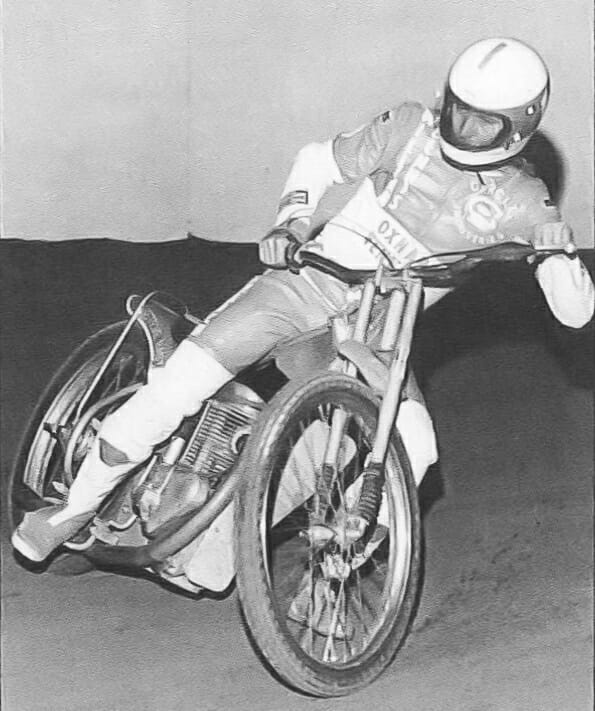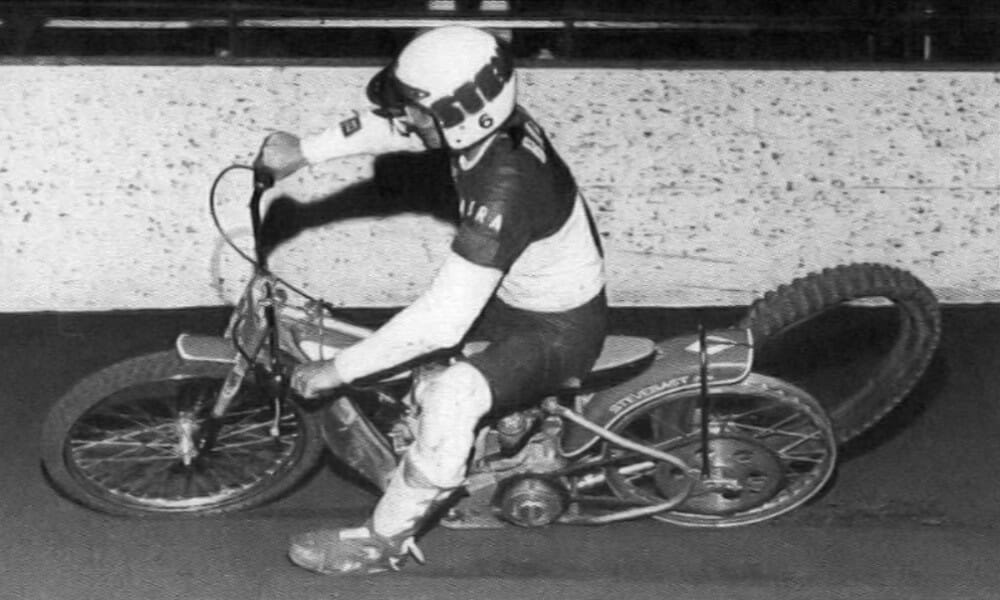Cycle News Staff | November 15, 2020
Cycle News Archives
COLUMN
This Cycle News Archives edition is reprinted from issue #36, September 14, 2005. CN has hundreds of past Archives columns in our files, too many destined to be archives themselves. So, to prevent that from happening, in the future, we will be revisiting past Archives articles while still planning to keep fresh ones coming down the road -Editor.
Speedway’s First Fast Bast
By Scott Rousseau
Throughout the heyday period of Southern California speedway that unfolded during the late 1960s and all of the 1970s, the name Bast has always figured prominently in the sport. Thanks in large part to the seven U.S. National Speedway Championship titles that Mike Bast won during his illustrious career, and much later when cousin Bart Bast returned the name to the U.S. National honor roll, the Bast family is amply qualified to be tabbed as the first family of American speedway.
 Steve Bast got the Bast ball rolling when it came to speedway racing back in the late 1960s and early ’70s.
Steve Bast got the Bast ball rolling when it came to speedway racing back in the late 1960s and early ’70s.
But neither Mike Bast nor Bart Bast was really the first fast Bast in speedway. Long overdue for such recognition, Steve Bast is the man who deserves it. And it isn’t just an arbitrary accolade, either. After all, Bast was the first U.S. National Speedway Champion in the sport.
Before speedway, Steve Bast was just one of the hundreds of Novice Class C flat trackers who invaded Ascot Park on a weekly basis, but then promoter Dude Criswell hatched the scheme to promote Class A speedway at Whiteman Stadium in Pacoima. Steve Bast and brother Mike Bast were among the first to step up.
“We only lived about 14 or 15 miles from there,” Steve Bast recalls. “Everybody heard that there were going to be some races going on there. So, my dad said, ‘Let’s go try it.’”
The timing was definitely good, not just because speedway would ultimately provide Bast with a newfound love that would serve as his profession for nearly a decade, but also because it sort of kept him from getting into the kind of trouble that could possibly have sidetracked any potential flat track career.
“I was only 16 years old,” Bast says. “I think that Keith [Mashburn] and Dave [Aldana] and a bunch of ’em got busted for cheating on their birth certificates. I did the same thing, only I didn’t get caught.”
Prior to heading to Whiteman, Bast had never ridden a speedway bike. Heck, he’d only ever seen one twice, and that one was located on the wall in a friend’s garage.
“We had a friend who had an old Rudge,” Bast recalls. “It was a totally restored trophy bike that [world-renowned pinstriper] Von Dutch restored for him. He pulled it off the wall so that we could go ride at Whiteman. In them days there were only four or five bikes, and everybody had to share, so Uncle Harlan [Bast], my brother, Mike, and myself and a couple other guys all rode that one bike. They ran Class C bikes up against us. It would’ve been nice if everybody had a JAP, but they’d use anything to fill up the program in those early days.”
Not too long after they started, the Basts picked up a JAP of their own.
“It had the leg brace and the old down bars,” Bast says. “It was an old, old bike, but we made it go. Mike has it right now. My nephew Ryan has it in boxes, and he’s going to have it restored completely.”
Bast confirms that Southern California speedway’s early days were loose and wild. Nobody really even knew how to ride the machines properly. Everyone used flat track riding styles to varying degrees of success. In 1969, things turned for the better when former World Speedway Champion Jack Milne and one of his motorcycle dealership employees, a young lad named Harry Oxley, partnered up to begin putting on weekly races at the Orange County Fairgrounds in Costa Mesa. At first, Bast’s father, Homer, was hesitant to take the boys down to Costa Mesa when Whiteman was so close.

“But we did finally go, and boy I couldn’t believe it,” Bast says. “It was a nice show. They had a nice oval, with grandstands all the way around. It was real speedway. We had to go every Friday night after that.”
As part of the deal, the two promoters brought over World Champion racers Ivan Mauger and Barry Briggs to school the Californians on proper speedway techniques. According to Bast, it changed everything.
“We didn’t know what we were doing, and then we saw them guys go, and everybody ran back to their bikes to lift the bars up and start standing up and everything,” Bast says. “That was it.”
The Bast boys adapted quicky, and Steve says that he just about quit riding Class C altogether.
“I just went for it in speedway,” Bast says. “It was the new thing.”
This new thing also attracted new spectators. Bast says that by the end of that first season, Costa Mesa was drawing between 2000 and 4000 spectators per night. The track’s promoters reciprocated by offering the racers an honest 30 to 35 percent of the gate. It all added up to big paydays for the top riders, such as the Basts, Rick Woods and Sonny Nutter. Even TT legend Eddie Mulder, a man whose senses are most acute at detecting the scent of greenbacks, came to race.
“I was making a lot of cash riding speedway,” Bast recalls. “At Ascot, my biggest payday was $15. We started at Costa Mesa, and all of sudden we were making between $200 and $400 per night.”
With speedway taking off, Bast’s JAP was quickly replaced by a state-of-the-art Jawa two-valve, just in time for the inaugural U.S. National Championship.
“We got about a half a season in on the Jawa before that National,” Bast says. “They would just fly.”
And by then, Bast knew how to make them fly. Scoring 14 of a possible 15 points, he became the inaugural U.S. National Speedway Champion. John Carter was second, and Rick Woods was third in that first race.
From then on, Bast remained a prominent player in speedway throughout most of the ’70s, trading U.S. National titles with Rick Woods and with brother Mike Bast. Steve Bast won the second of his two U.S. National titles in 1974 aboard another two-valve Jawa, and he was almost able to defend it in ’75, but a miscalculation would cost him the title.
“I rode the very first Weslake that came into the country,” Bast says. “A friend had imported it, and we got it ready for the championship. I did real good in the early heats, but then I made the decision to go to a higher gear, which I shouldn’t have done. I should have gone to a lower gear. I couldn’t even keep it on the track after that. I had won the first two heats, but then after that, I felt like a guy with two left feet. I would have won if I hadn’t made the wrong decision.”
Bast would never win another U.S. National Championship, although brother Mike, who won the ’75 U.S. National, would go on to win it another four times for a total of seven titles. But Steve and Mike Bast are level on California State Speedway Championships, each man holding six. “Yeah, that was one thing where I won it six times, and Mike told me that he wouldn’t quit until he tied me,” Bast says.
Bast would back away from full-time active status in the Southern California speedway scene in 1976, electing to move to Northern California, where he won the Northern California Speedway Championship. He would fly back and forth between the north and the south in 1978 and ’79, but that proved to be too much of a grind.
“That got to be a hassle, so I quit completely,” Bast says, “but I did come back one more time. I rode the ’81 or ’82 season—I can’t remember which. I rode for George Wenn and Vans. I had a few good sponsors, but it was only a one-season deal. And by then, there was a whole new breed of cat coming into speedway.”
The scene was changing, Bast says—not necessarily for the worse, but still changing.
“It wasn’t the same,” Bast says. “It was still fun to see all my old friends and fans, and I made the whole season, but after that, I moved back up north and said, ‘Forget it.’”
Bast has no regrets about the time he spent chasing his motorcycle racing dreams.
“Those were fun days, and it was cheap fun,” Bast recalls. “We used to buy tires at $25 apiece in bulk. Fuel was cheap, oil was cheap, and gasoline was cheap to get there. It was just a whole different deal. The promoters weren’t greedy. They were learning right along with the riders. That [speedway] was my business for seven years, and I got to see a lot of the world with the U.S. Team. My brother and I went to Australia and New Zealand. It was great for me.”CN
Editor’s Note: Steve Bast passed away in 2007 at 55 years of age.